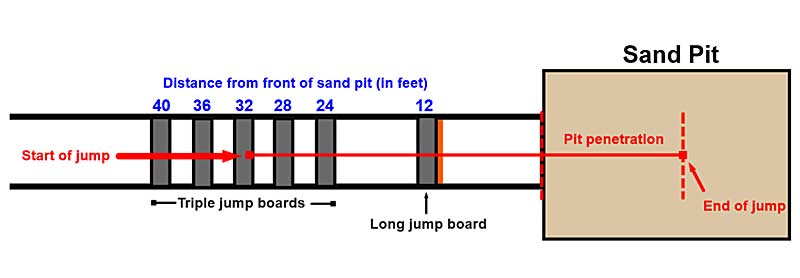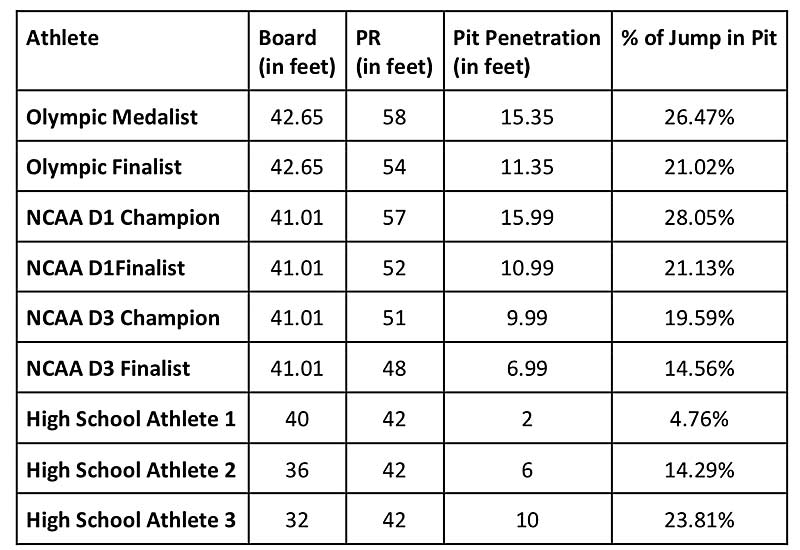

Scene: The triple leap competitors at a highschool close to you.
An athlete prepares to take his third triple leap try. His earlier jumps have been fouls. He wants to satisfy or higher his private report to get an extra three jumps in finals. He raises his palms and begins a sluggish clap. The group complies. The jumper begins his acceleration down the runway, constructing pace. He takes off on the 40-foot board. The hop seems to be good. The step is strong. And the leap…leaves him in need of the sand. The group reacts with a puff on the awkward touchdown on his proper foot. His leg crumbles, and he rotates ahead. The result’s a faceplant within the sand.
I’ve been to greater than 400 observe competitions in my lifetime, and ending a triple leap in need of the pit is one thing that occurs on the overwhelming majority of them. As an “occasion official,” I’ve recurrently noticed triple jumpers “fouling out”—not on account of being over the foul line at take-off, however as a result of they fail to succeed in the sand. This disagreeable and embarrassing occasion, which might end in an harm, merely doesn’t need to occur as typically because it does.
What might have preceded what occurred within the situation above? Let’s say that the jumper had a private report of 42 ft that he attained on the earlier meet, the place he took off from the 36-foot board (which he had been doing all season). Earlier than that, his typical efficiency at competitions was between 39 and 41 ft. After his PR efficiency of 42 ft, he lastly felt like he “graduated” to having the ability to go from the 40-foot board.
Why do highschool jumpers have a want to go from an extended board? The reply is straightforward: standing. I equate it to an analogous incidence within the weight room.
Why do high school jumpers have a desire to go from a longer board? The answer is simple: status, says @HFJumps. Click To Tweet
I keep in mind the primary time I might bench press 135 kilos in a exercise. The units have been 120, 125, 130, 135. Regardless that it will have been easier to only add a ten to every aspect for the ultimate set, I made positive to strip the bar and throw on 45s. I wished to showcase that I used to be able to dealing with them.
The distinction on this state of affairs is 135 kilos is 135 kilos. There is no such thing as a extra threat in attending to 135 kilos with the 35/10 combo or a single 45. There is extra threat when one chooses to take off from an additional board, as the instance clearly reveals. You probably have witnessed the failure of a jumper to enter the pit of their third section, you realize that it typically seems to be (and is) painful. In an occasion the place there’s already an excessive quantity of power, there isn’t any want so as to add to what an athlete must take care of, particularly when it’s pointless.

By the Numbers
The very best male triple jumpers on this planet have performances near 60 ft, and the board they typically leap from is 42.65 ft (13 meters). If the world-class triple jumper jumps 58 ft, the pit penetration of their leap (quantity of the leap that’s over the sand) is 15.35 ft (58 ft – 42.65 ft). The proportion of the leap that’s over the sand might be discovered by dividing the pit penetration by their efficiency. On this case, 15.35 ft/58 ft = 26.47%.
The desk beneath reveals frequent board lengths, performances, pit penetration, and proportion of leap within the pit at varied ranges.

The outlier within the desk above is Excessive College Athlete 1, with 4.76% of his leap occurring over the pit. In my expertise, this case is a daily incidence at highschool meets and invitationals. To be trustworthy, I believe if an athlete persistently performs beneath 10% of pit penetration, the coach is being irresponsible, or the athlete is blatantly ignoring the coach’s recommendation.
After all, there are exceptions to each state of affairs. Years in the past, I had an athlete who was present process a stretch of dangerous competitions. He was persistently underperforming and getting actually down on himself. We have been in our final competitors of the indoor season, and his first three makes an attempt have been beneath 40 ft from the 36-foot board.
He and I had battled as to which board he ought to use for a lot of the indoor season, and we compromised on the 36-foot board although I’d have most well-liked the 32-foot board, along with his earlier private report being simply over 40 ft. For his final try, he requested to leap from the 40-foot board. I conceded as a result of I felt the hazard of him being mentally broken heading into the outside season was better than the potential of bodily injury. He wanted a win, and I used to be out of different choices. To my shock, he ended up leaping a season finest by almost 2 ft on his ultimate try.
The positives from this case have been that he left the competitors in a constructive mind-set for the primary time in six weeks, and it strengthened the belief he had in me as his coach. (I listened to his request.) The detrimental was that the method he utilized to get into the pit was not sustainable.
The specter of not making it into the pit can definitely trigger an athlete to entry non permanent “superhero” talents, however many instances, it comes at a value. On this case, there was extreme reaching coming off the step section into the leap, creating an extreme quantity of braking power (the foot contacts the bottom too far in entrance of the middle of mass). That is frequent when an athlete is confronted with the specter of not touchdown within the pit, in all probability because of the mind telling them to do no matter is feasible to get nearer to the sand.
So, whereas he didn’t pay the price of touchdown in need of the pit, there was nonetheless a value of coping with an excessive amount of power between section two and section three. If he have been to proceed to carry out on this method, finally, the physique would break down. Simply because an individual can eat a weight-reduction plan of tater tots and Swedish fish each day doesn’t imply they need to. There can be a worth to pay in some unspecified time in the future.
Motion Steps
I prefer to hold issues easy. As a substitute of me or my athletes calculating the numbers within the desk above, I’ve athletes do some extremely easy subtraction. Notice that I take advantage of ft on this state of affairs as a result of that’s usually what triple leap board methods are at the highschool degree in Illinois, although occasion outcomes are metric. Normally, I desire pit penetration to be between 6 ft and 10 ft.
The common efficiency might be information constructed over the yr (we often ignore the inches in calculating the typical). I’m usually extra within the common over time than the athlete’s private report. Using the non-public report can result in the state of affairs outlined at the start of the article.
- I instruct the athletes to carry out the next arithmetic to realize a spread of values:
-
- Common efficiency (in ft) – 6 ft
- Common efficiency (in ft) – 8 ft
- Common efficiency (in ft) – 10 ft
Instance:
- Athlete’s efficiency over two competitions:
- 41-6, 40-5, 39-7, 40-0
- 42-0, 40-11, 40-3, 43-6
- Common Efficiency:
- (41 + 40 + 39 + 40 + 42 + 40 + 40 + 43)/8 = 40.625
- Common Efficiency – Pit Penetration = Board Risk
- 40.625 – 6 = 34.625
- 40.625 – 8 = 32.625
- 40.625 – 10 = 30.625
Heading into the subsequent meet, I’d nonetheless advise this athlete to make the most of the 32-foot board. For my part, regardless of a particular enchancment, there’s not sufficient information to help transferring to the 36-foot board. If he continued to progress and add extra information with jumps that have been 42 ft and above, we’d progress to the 36-foot board.
Coaches must also concentrate on the situations by which outcomes happen. I’ll throw out information from a meet that occurred in excessive climate or facility situations (chilly, wind, rain, warmth, and/or a pit with sand 8 inches beneath the runway are all on the desk right here). Normally, be conservative heading right into a meet with poor climate situations (perhaps go down a board) and be constant in a meet with ideally suited climate situations (use the board you usually use).
In general, be conservative heading into a meet with poor weather conditions (maybe go down a board) and consistent in a meet with ideal weather conditions (use the board you typically use). Click To Tweet
This additionally connects to a different necessary level. Whereas athletes could desire a specific triple leap board, they should be adaptable. In Illinois, the usual board system is 24/28/32/36/40. Nonetheless, not all services have this setup (or the situation of a number of of the boards will not be secure to take off from). Early in my profession, I heard athletes say one thing like, “I’d have jumped higher, however they didn’t have a 40-foot board, so I needed to leap from a 38-foot board.” Whereas my preliminary thought was to say, “It’s essential be extra athletic than that,” I held my tongue. I noticed that I wanted to create conditions and ship messages to boost their adaptability.
First, I modify up take-off positions throughout brief method work all year long and emphasize that board distance doesn’t impression our skill to do the job. From there, if I do know we’re going to head to a meet that has a unique board setup than ours (I hold in depth notes of every facility we go to), I say one thing easy like: “Their board system is totally different than ours, however we’ve got practiced executing from a spread of take-off positions all yr. You’re prepared.” Along with this, I might also attempt to replicate what they’ll see at a facility to the most effective of my skill. Athletes who’re snug are likely to carry out higher.
I change up take-off positions during short approach work throughout the year and emphasize that board distance does not impact our ability to do the job, says @HFJumps. Click To Tweet
End within the Pit!
In Illinois in 2023, there have been 1,860 athletes with a triple leap mark. 100 forty of them have been 42 ft or farther. Might a few of the 1,720 beneath 42 ft go from a board longer than 32 ft? Certain. Do they want to? No!
One frequent ratio for triple leap phases is 35%–30%–35% (proportion of the full leap distance for section 1–section 2–section 3). If we mix the primary two phases’ percentages (65%) and multiply that by a 42-foot efficiency, we get 27.3 ft. So, if a 42-foot triple jumper took off from a 32-foot board, they might be 4.7 ft (32-27.3) from the beginning of the pit heading into their ultimate section.
This jumper might persistently leap from the 36-foot board however doesn’t want to—there in all probability isn’t a lot of an opportunity that they might land within the sand coming off their second section from the 32-foot board. For my part, this jumper mustn’t persistently leap from the 40-foot board. The chance isn’t well worth the reward.
Because you’re right here…
…we’ve got a small favor to ask. Extra individuals are studying SimpliFaster than ever, and every week we deliver you compelling content material from coaches, sport scientists, and physiotherapists who’re dedicated to constructing higher athletes. Please take a second to share the articles on social media, interact the authors with questions and feedback beneath, and hyperlink to articles when applicable in case you have a weblog or take part on boards of associated matters. — SF
